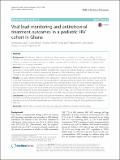| dc.contributor.author | Kukoyi, Omobolawa | en_US |
| dc.contributor.author | Renner, Lorna | en_US |
| dc.contributor.author | Powell, Jonathan | en_US |
| dc.contributor.author | Barry, Oliver | en_US |
| dc.contributor.author | Prin, Meghan | en_US |
| dc.contributor.author | Kusah, Jonas | en_US |
| dc.contributor.author | Cong, Xiangyu | en_US |
| dc.contributor.author | Paintsil, Elijah | en_US |
| dc.date.accessioned | 2016-03-01T19:49:17Z | |
| dc.date.issued | 2016 | en_US |
| dc.identifier.citation | Kukoyi, Omobolawa, Lorna Renner, Jonathan Powell, Oliver Barry, Meghan Prin, Jonas Kusah, Xiangyu Cong, and Elijah Paintsil. 2016. “Viral load monitoring and antiretroviral treatment outcomes in a pediatric HIV cohort in Ghana.” BMC Infectious Diseases 16 (1): 58. doi:10.1186/s12879-016-1402-9. http://dx.doi.org/10.1186/s12879-016-1402-9. | en |
| dc.identifier.issn | 1471-2334 | en |
| dc.identifier.uri | http://nrs.harvard.edu/urn-3:HUL.InstRepos:25658400 | |
| dc.description.abstract | Background: HIV-infected children in sub-Saharan Africa may be at a high risk of staying on a failing first-line regimen and developing drug-resistance HIV variants due to lack of routine viral load monitoring. We investigated whether cumulative viral load, measured as viremia copy-years (VCY) could predict morbidity in a setting where viral load is not routinely monitored. Methods: This was a single-center prospective observational longitudinal study of HIV-infected children initiating antiretroviral therapy (ART) at the Pediatric HIV/AIDS Care program at Korle-Bu Teaching Hospital in Accra, Ghana. The main outcome was morbidity measured as frequency of hospitalizations, opportunistic infections, and outpatient sick visits. The main explanatory variable was viral load measured as VCY. Results: The study included 140 children who initiated ART between September 2009 and May 2013 and had at least 2 viral load measurements. There were 184 hospitalizations, with pneumonia being the most common cause (22.8 %). A total of 102 opportunistic infections was documented, with tuberculosis being the most common opportunistic infection (68 %). A total of 823 outpatient sick visits was documented, with upper respiratory infections (14.2 %) being the most common cause. Forty-four percent of our study participants had >4 log10 VCY. Children in this sub-cohort had a higher frequency of sick visits compared with those with <4 log10 VCY (p = 0.03). Only 6.5 % of children with >4 log10 VCY had been identified as treatment failure using WHO clinical and immunological treatment failure criteria. Conclusions: High level of cumulative viral load may translate to virological failure and subsequent increased all-cause morbidity. Our finding of potential utility of VCY in pediatrics warrants further investigations. VCY may be a good alternate to routine viral load measurement as its determination may be less frequent and could be personalized to save cost. | en |
| dc.language.iso | en_US | en |
| dc.publisher | BioMed Central | en |
| dc.relation.isversionof | doi:10.1186/s12879-016-1402-9 | en |
| dc.relation.hasversion | http://www.ncbi.nlm.nih.gov/pmc/articles/PMC4738803/pdf/ | en |
| dash.license | LAA | en_US |
| dc.subject | Pediatric HIV | en |
| dc.subject | Cumulative viral load | en |
| dc.subject | viral copy years | en |
| dc.subject | Morbidity | en |
| dc.subject | Resource-limited setting | en |
| dc.title | Viral load monitoring and antiretroviral treatment outcomes in a pediatric HIV cohort in Ghana | en |
| dc.type | Journal Article | en_US |
| dc.description.version | Version of Record | en |
| dc.relation.journal | BMC Infectious Diseases | en |
| dash.depositing.author | Barry, Oliver | en_US |
| dc.date.available | 2016-03-01T19:49:17Z | |
| dc.identifier.doi | 10.1186/s12879-016-1402-9 | * |
| dash.contributor.affiliated | Barry, Oliver | |


